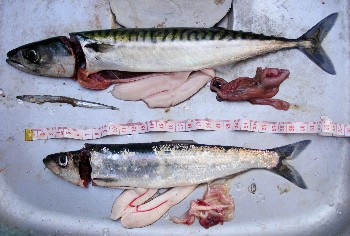Spring spawning herring to the west of Melvaig?
Posted: Wednesday 12 April, 2017 @ 02:13:08

For a long time I’ve been curious to learn more about the seabed to the west of Melvaig. On 26th March 2017, with bright sunshine and the tide already far out, it seemed like a good day for exploring. So whilst having a cup of tea, I rigged up an improvised drop-down camera using 2 coat hangers, duck-tape, some rubber bands, and my GoPro Hero camera, and secured the rig on the end of a fishing line.
It all worked well. By dropping the camera over the side of my kayak every 150 to 200m or so out from the slipway, I recorded 9 videos each of about 3 minutes. The seabed is mostly stony with seaweeds growing from the stones and waves of shell sand in between. There were many starfish, a few sea urchins, and in one video a small plaice can be seen which narrowly avoided being landed upon by the contraption on the end of my line.
However, what was happening closer to the surface was also interesting. Around my kayak there was an oily scum on the surface of the water with many bubbles. I realised there were thousands of tiny fish fry, mostly of around ~8mm in length in the water beside me, sparkling in the sunshine; millions of them within the surrounding area. I tried to record them using a close-up lens on my video camera, without great success. There were also several seals nearby (both common and grey), and from time to time small bubbles came up to the surface all around my kayak as if I was floating on a very large fizzy drink.
When the wee window on my camera indicated that the memory card was full, I took off the drop-down rig and swapped it for a line with two mackerel lures on it and then paddled towards where the gannets had been diving in about 1km away. After only a few minutes of fishing, I caught a mackerel; the first time I've had one in March. Then, a few minutes later, I heard and then saw a shoal of fish on the surface just behind me; so I turned and paddled towards them.
The fish had their mouths open as if they were filtering-feeding on surface plankton; I’ve seen mackerel feeding like this in the summer time. As I approached, they dived below my kayak but not far below; and I could still see them as I pulled my fishing line through the shoal. Just as I realised they were not mackerel, one of them took a lure. I landed a herring.
Seals followed me all the way back in to the shore.
Both the mackerel (302mm) and the herring (235mm) were mature male fish in close to spawning condition. There was a freshly eaten sandeel inside the mackerel; however the stomach of the herring seemed to be empty. Both of the fish were rather thin; they are better eating later in the year.
Subsequently I’ve learned that herring sometimes release bubbles from their swim bladder when disturbed. They refill their swim bladders by gulping air; so that is one possible explanation for seeing a shoal of them on the surface of the sea with mouths wide open in the middle of a bright sunny day. How often do other fishermen see this?
All the signs suggested to me that the herring and mackerel were in the area to spawn; and that spawning had been taking place nearby during preceding weeks.
When interviewed in previous years many of those who fished for herring in the past said that the seabed to the west of Melvaig was an important spawning ground for herring in March; and so it may still be?
I’ve never seen so many fish fry before: these could also be sampled to find out whether many of them are of herring.
To be able to survey the seabed in deeper water, I’ve subsequently bought an underwater light for my camera.
Any practical support from fishermen or anyone else for investigations to learn more about herring spawning grounds around Wester Ross and Skye would be much appreciated.
Note that in 2011 and 2012, Sue Pomeroy interviewed some of the fishermen who had fished for herring around Wester Ross in the 1960s, 1970s and into the 1980s, as part of a project with Two Lochs Radio and Gairloch Heritage Museum, supported by the Wester Ross Environment Network.
Subsequently student Ruby Neervoort transcribed the interviews and compiled some of the stories; her thesis can be found at: http://www.wrft.org.uk/files/final%20report%20Ruby%20Neervoort%201898558%20(1).pdf .
Peter Cunningham, info@wrft.org.uk